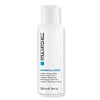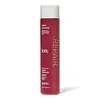What's inside
What's inside
 Key Ingredients
Key Ingredients

 Benefits
Benefits

 Concerns
Concerns

 Ingredients Side-by-side
Ingredients Side-by-side

Water
Skin ConditioningDisodium Cocoamphodiacetate
CleansingSodium Laureth Sulfate
CleansingUrea
BufferingMagnesium Sulfate
Sodium Chloride
MaskingSodium Thiosulfate
Glycine
BufferingLeucine
Skin ConditioningTyrosine
MaskingCysteine
AntioxidantSymphytum Officinale Leaf Extract
Skin ConditioningPlantago Major Leaf Extract
Skin ConditioningHydrolyzed Wheat Protein
Skin ConditioningSulfated Castor Oil
CleansingBisamino PEG/PPG-41/3 Aminoethyl Pg-Propyl Dimethicone
Disodium EDTA
Disodium EDTA-Copper
AstringentMagnesium Carbonate
AbsorbentPEG-12 Dimethicone
Skin ConditioningTetrasodium EDTA
Trisodium Hedta
Sodium Glycolate
BufferingSodium Hydroxide
BufferingPhenoxyethanol
PreservativeMethylchloroisothiazolinone
PreservativeMethylisothiazolinone
PreservativeMagnesium Chloride
Magnesium Nitrate
Parfum
MaskingLimonene
PerfumingWater, Disodium Cocoamphodiacetate, Sodium Laureth Sulfate, Urea, Magnesium Sulfate, Sodium Chloride, Sodium Thiosulfate, Glycine, Leucine, Tyrosine, Cysteine, Symphytum Officinale Leaf Extract, Plantago Major Leaf Extract, Hydrolyzed Wheat Protein, Sulfated Castor Oil, Bisamino PEG/PPG-41/3 Aminoethyl Pg-Propyl Dimethicone, Disodium EDTA, Disodium EDTA-Copper, Magnesium Carbonate, PEG-12 Dimethicone, Tetrasodium EDTA, Trisodium Hedta, Sodium Glycolate, Sodium Hydroxide, Phenoxyethanol, Methylchloroisothiazolinone, Methylisothiazolinone, Magnesium Chloride, Magnesium Nitrate, Parfum, Limonene
Water
Skin ConditioningSodium Laureth Sulfate
CleansingCocamidopropyl Betaine
CleansingGlycol Distearate
EmollientPhenoxyethanol
PreservativeParfum
MaskingLaureth-4
EmulsifyingPolyquaternium-10
Sodium Chloride
MaskingSodium Benzoate
MaskingPolyquaternium-7
Ethylhexylglycerin
Skin ConditioningGuar Hydroxypropyltrimonium Chloride
Skin ConditioningLaureth-2
CleansingPEG/PPG-120/10 Trimethylolpropane Trioleate
Lactic Acid
BufferingLinalool
PerfumingDimethicone PEG-8 Meadowfoamate
EmollientTocopheryl Acetate
AntioxidantPanthenol
Skin ConditioningPropylene Glycol
HumectantHydrolyzed Quinoa
Skin ConditioningPotassium Sorbate
PreservativeWater, Sodium Laureth Sulfate, Cocamidopropyl Betaine, Glycol Distearate, Phenoxyethanol, Parfum, Laureth-4, Polyquaternium-10, Sodium Chloride, Sodium Benzoate, Polyquaternium-7, Ethylhexylglycerin, Guar Hydroxypropyltrimonium Chloride, Laureth-2, PEG/PPG-120/10 Trimethylolpropane Trioleate, Lactic Acid, Linalool, Dimethicone PEG-8 Meadowfoamate, Tocopheryl Acetate, Panthenol, Propylene Glycol, Hydrolyzed Quinoa, Potassium Sorbate
Ingredients Explained
These ingredients are found in both products.
Ingredients higher up in an ingredient list are typically present in a larger amount.
Parfum is a catch-all term for an ingredient or more that is used to give a scent to products.
Also called "fragrance", this ingredient can be a blend of hundreds of chemicals or plant oils. This means every product with "fragrance" or "parfum" in the ingredients list is a different mixture.
For instance, Habanolide is a proprietary trade name for a specific aroma chemical. When used as a fragrance ingredient in cosmetics, most aroma chemicals fall under the broad labeling category of “FRAGRANCE” or “PARFUM” according to EU and US regulations.
The term 'parfum' or 'fragrance' is not regulated in many countries. In many cases, it is up to the brand to define this term.
For instance, many brands choose to label themselves as "fragrance-free" because they are not using synthetic fragrances. However, their products may still contain ingredients such as essential oils that are considered a fragrance by INCI standards.
One example is Calendula flower extract. Calendula is an essential oil that still imparts a scent or 'fragrance'.
Depending on the blend, the ingredients in the mixture can cause allergies and sensitivities on the skin. Some ingredients that are known EU allergens include linalool and citronellol.
Parfum can also be used to mask or cover an unpleasant scent.
The bottom line is: not all fragrances/parfum/ingredients are created equally. If you are worried about fragrances, we recommend taking a closer look at an ingredient. And of course, we always recommend speaking with a professional.
Learn more about ParfumPhenoxyethanol is a preservative that has germicide, antimicrobial, and aromatic properties. Studies show that phenoxyethanol can prevent microbial growth. By itself, it has a scent that is similar to that of a rose.
It's often used in formulations along with Caprylyl Glycol to preserve the shelf life of products.
Chances are, you eat sodium chloride every day. Sodium Chloride is also known as table salt.
This ingredient has many purposes in skincare: thickener, emulsifier, and exfoliator.
You'll most likely find this ingredient in cleansers where it is used to create a gel-like texture. As an emulsifier, it also prevents ingredients from separating.
There is much debate on whether this ingredient is comedogenic. The short answer - comedogenic ratings don't tell the whole story. Learn more about comegodenic ratings here.
The concensus about this ingredient causing acne seems to be divided. Research is needed to understand if this ingredient does cause acne.
Scrubs may use salt as the primary exfoliating ingredient.
Learn more about Sodium ChlorideSodium Laureth Sulfate (SLES) is a foaming, cleansing, and emulsifying ingredient. It is created from palm kernel oil or coconut oil. SLES is not the same as sodium lauryl sulfate. It is much milder and less likely to irritate.
SLES helps create foam in personal products. It also prevents ingredients from separating, helping to elongate the shelf life.
Sodium Laureth Sulfate is a type of sulfate. It can be drying. We recommend speaking with a professional about using this ingredient if you have concerns.
Learn more about Sodium Laureth SulfateWater. It's the most common cosmetic ingredient of all. You'll usually see it at the top of ingredient lists, meaning that it makes up the largest part of the product.
So why is it so popular? Water most often acts as a solvent - this means that it helps dissolve other ingredients into the formulation.
You'll also recognize water as that liquid we all need to stay alive. If you see this, drink a glass of water. Stay hydrated!
Learn more about Water